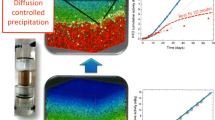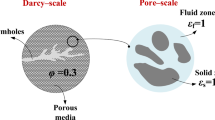Abstract
In several hydrogeochemical situations, there is an interaction between the solid matrix and the carbonate species according to calcite dissolution and precipitation reactions (evaporate deposition in Sebkha and Chotts, calcite dissolution in seawater–freshwater mixing zone). The precipitation of such rocks can easily induce a development of the porosity and permeability as a result of the mixing processes of two different solutions. The purpose of this work is to present a relatively complete modeling tool to evaluate the porosity decrease during calcite precipitation and their impacts on the flow and transport. The modeling of such problem requires a set of highly nonlinearly coupled equations. GEODENS code, used in this work, can solve these equations by a finite element procedure. It can handle geochemical reactions such as mineral dissolution-precipitation reaction. The coupled model iteratively calculates the fluid pressure, the ion concentrations and the quantities of the different salts that may precipitate or dissolve in the domain over time. The porosity is calculated by considering the pore volume invaded during calcite precipitation in every node and each time step. The new porosity value is used to update the permeability using empirical model. The new hydrodynamic distribution is the new inputs for the next time step to solve the flow and reactive transport problem.







Similar content being viewed by others
References
Bear J (1988) Dynamics of fluids in porous media. Elsevier, New York
Bouhlila R (1999) Ecoulements, transports et réactions géochimiques couplés dans les milieux poreux. Cas des sels et des saumures. doi:10.13140/2.1.2270.0808 (in French)
Bouhlila R, Laabidi E (2008) Impacts of calcite dissolution on seawater intrusion processes in coastal aquifers: density dependent flow and multi species reactive transport modelling. IAHS-AISH Publ 320:220–225
Chen J, Qian H, Li P (2013) Mixing precipitation of CaCO3 in natural waters. Water 5:1712
De Marsily G (1981) Quantitative hydrogeology. Ed. Masson, Paris (in French)
Diersch H, Kolditz O (2002) Variable-density flow and transport in porous media: approaches and challenges. Adv Water Resour 25:899–944
Emmanuel S, Berkowitz B (2005) Mixing-induced precipitation and porosity evolution in porous media. Adv Water Resour 28:337–344. doi:10.1016/j.advwatres.2004.11.010
Eriksson N, Destouni G (1997) Combined effects of dissolution kinetics, secondary mineral precipitation, and preferential flow on copper leaching from mining waste rock. Water Resour Res 33:471–483. doi:10.1029/96WR03466
Freedman V, Ibaraki M (2002) Effects of chemical reactions on density-dependent fluid flow: on the numerical formulation and the development of instabilities. Adv Water Resour 25:439–453. doi:10.1016/S0309-1708(01)00056-2
Fujita Y et al (2008) Stimulation of microbial urea hydrolysis in groundwater to enhance calcite precipitation. Environ Sci Technol 42:3025–3032
Hilgers C, Urai JL (2002) Experimental study of syntaxial vein growth during lateral fluid flow in transmitted light: first results. J Struct Geol 24:1029–1043. doi:10.1016/S0191-8141(01)00089-X
Katz GE, Berkowitz B, Guadagnini A, Saaltink MW (2011) Experimental and modeling investigation of multicomponent reactive transport in porous media. J Contam Hydrol 120–121:27–44. doi:10.1016/j.jconhyd.2009.11.002
Laabidi E, Bouhlila R (2015) Nonstationary porosity evolution in mixing zone in coastal carbonate aquifer using an alternative modeling approach. Environ Sci Pollut Res 22:10070–10082. doi:10.1007/s11356-015-4207-2
Lee Y-J, Morse JW (1999) Calcite precipitation in synthetic veins: implications for the time and fluid volume necessary for vein filling. Chem Geol 156:151–170. doi:10.1016/S0009-2541(98)00183-1
Monnin C (1989) An ion interaction model for the volumetric properties of natural waters: density of the solution and partial molal volumes of electrolytes to high concentrations at 25 °C. Geochim Cosmochim Acta 53:1177–1188. doi:10.1016/0016-7037(89)90055-0
Pitzer KS, Peiper JC, Busey RH (1984) Thermodynamic properties of aqueous sodium chloride solutions. J Phys Chem Ref Data 13:1–102
Plummer LN (1975) Mixing of sea water with calcium carbonate ground water. Geol Soc Am Mem 142:219–236. doi:10.1130/MEM142-p219
Price RM, Herman JS (1991) Geochemical investigation of salt-water intrusion into a coastal carbonate aquifer: Mallorca, Spain. Geol Soc Am Bull 103:1270–1279. doi:10.1130/0016-7606(1991)103<1270:gioswi>2.3.co;2
Qian H, Li P (2011) Mixing corrosion of CaCO3 in natural waters. E J Chem. doi:10.1155/2011/891053
Qian H, Li P (2012) Proportion dependent mixing effects of CaCO3 in natural waters. Asian J Chem 24:2257
Rege SD, Fogler HS (1989) Competition among flow, dissolution, and precipitation in porous media. AIChE J 35:1177–1185. doi:10.1002/aic.690350713
Saaltink MW, Ayora C, Batlle F, Carrera J, Olivella S (2004) RETRASO, a code for modeling reactive transport in saturated and unsaturated porous media. Geologica Acta 2:235–251
Sanford WE, Konikow LF (1989) Simulation of calcite dissolution and porosity changes in saltwater mixing zones in coastal aquifers. Water Resour Res 25:655–667. doi:10.1029/WR025i004p00655
Singurindy O, Berkowitz B (2003) Evolution of hydraulic conductivity by precipitation and dissolution in carbonate rock. Water Resour Res 39:1016. doi:10.1029/2001WR001055
Singurindy O, Berkowitz B, Lowell RP (2004) Carbonate dissolution and precipitation in coastal environments: laboratory analysis and theoretical consideration. Water Resour Res 40:W04401. doi:10.1029/2003WR002651
Stumm W, Morgan JJ (1970) Aquatic chemistry: an introduction emphasizing chemical equilibria in natural waters, vol 1. Wiley
Tartakovsky AM, Redden G, Lichtner PC, Scheibe TD, Meakin P (2008) Mixing‐induced precipitation: experimental study and multiscale numerical analysis. Water Resour Res 44. doi:10.1029/2006WR005725
Yoon H, Valocchi AJ, Werth CJ, Dewers T (2012) Pore‐scale simulation of mixing‐induced calcium carbonate precipitation and dissolution in a microfluidic pore network. Water Resour Res 48. doi:10.1029/2011WR011192
Zhang C et al (2010) Pore-scale study of transverse mixing induced CaCO3 precipitation and permeability reduction in a model subsurface sedimentary system. Environ Sci Technol 44:7833–7838
Author information
Authors and Affiliations
Corresponding author
Rights and permissions
About this article
Cite this article
Laabidi, E., Bouhlila, R. Impact of mixing induced calcite precipitation on the flow and transport. Carbonates Evaporites 32, 473–485 (2017). https://doi.org/10.1007/s13146-016-0305-6
Accepted:
Published:
Issue Date:
DOI: https://doi.org/10.1007/s13146-016-0305-6




